Introduction
In the dynamic field of software engineering, the infrastructure that supports application development and deployment plays a pivotal role in determining the success of projects. This foundational framework encompasses a variety of components, from hardware and software to networking and cloud services, each contributing to the robustness and efficiency of software systems.
As organizations increasingly rely on these elements to navigate complex technological landscapes, understanding their intricacies becomes essential for professionals in the industry. This article delves into the key concepts and components of software engineering infrastructure, the critical responsibilities of infrastructure engineers, and the emerging trends shaping this domain.
By exploring common challenges and best practices, readers will gain valuable insights into managing infrastructure effectively, ensuring that their organizations remain competitive and agile in an ever-evolving environment.
Defining Software Engineering Infrastructure: Key Concepts and Components
In the realm of software engineering, the infrastructure in software engineering serves as the foundational framework that supports the development, deployment, and operation of applications. This framework includes various components crucial for creating a robust development environment, encompassing hardware, applications, networking, and cloud services. Key concepts include:
- Hardware: This encompasses physical servers, storage solutions, and networking equipment that provide the computational power and connectivity required for applications to function efficiently.
- Software: Encompassing operating platforms, middleware, and application software, these elements facilitate both the development and execution of applications, ensuring seamless performance.
- Networking: The communication protocols and framework that enable data transfer between diverse systems and users are crucial for ensuring smooth interaction and collaboration within teams.
- Cloud Services: Organizations are increasingly embracing cloud systems to enhance scalability and flexibility, permitting dynamic resource allocation in response to fluctuating demand.
Expenditure on Generative AI in application development is projected to surge from $41 billion in 2023 to an impressive $287.4 billion by 2033, reflecting a compound annual growth rate (CAGR) of 21.5%. This trend highlights the importance of cloud services in improving application development efficiency.
Alongside these elements, overall business needs must be considered in every platform, including speed to market, scalability, security, cost-effectiveness, and resilience. Additionally, a plan for recruiting, retraining, and retaining skilled staff is essential to support delivery teams efficiently, tackling the human element of systems that is crucial for application development. Moreover, the application development sector encounters difficulties in attaining workforce diversity, as shown by the case study on diversity in application development, which indicates that only 20% of employees are women and a considerable segment identifies as White.
Although diversity initiatives exist, advancement is gradual, highlighting the necessity for a more inclusive strategy in tech education and recruitment practices.
A thorough comprehension of these elements is essential for developers and companies alike, as the effectiveness and dependability of systems are largely reliant on a well-organized framework. This essential knowledge not only guides the strategic planning of systems but also prepares for a more profound examination of the roles and responsibilities related to these frameworks in engineering.
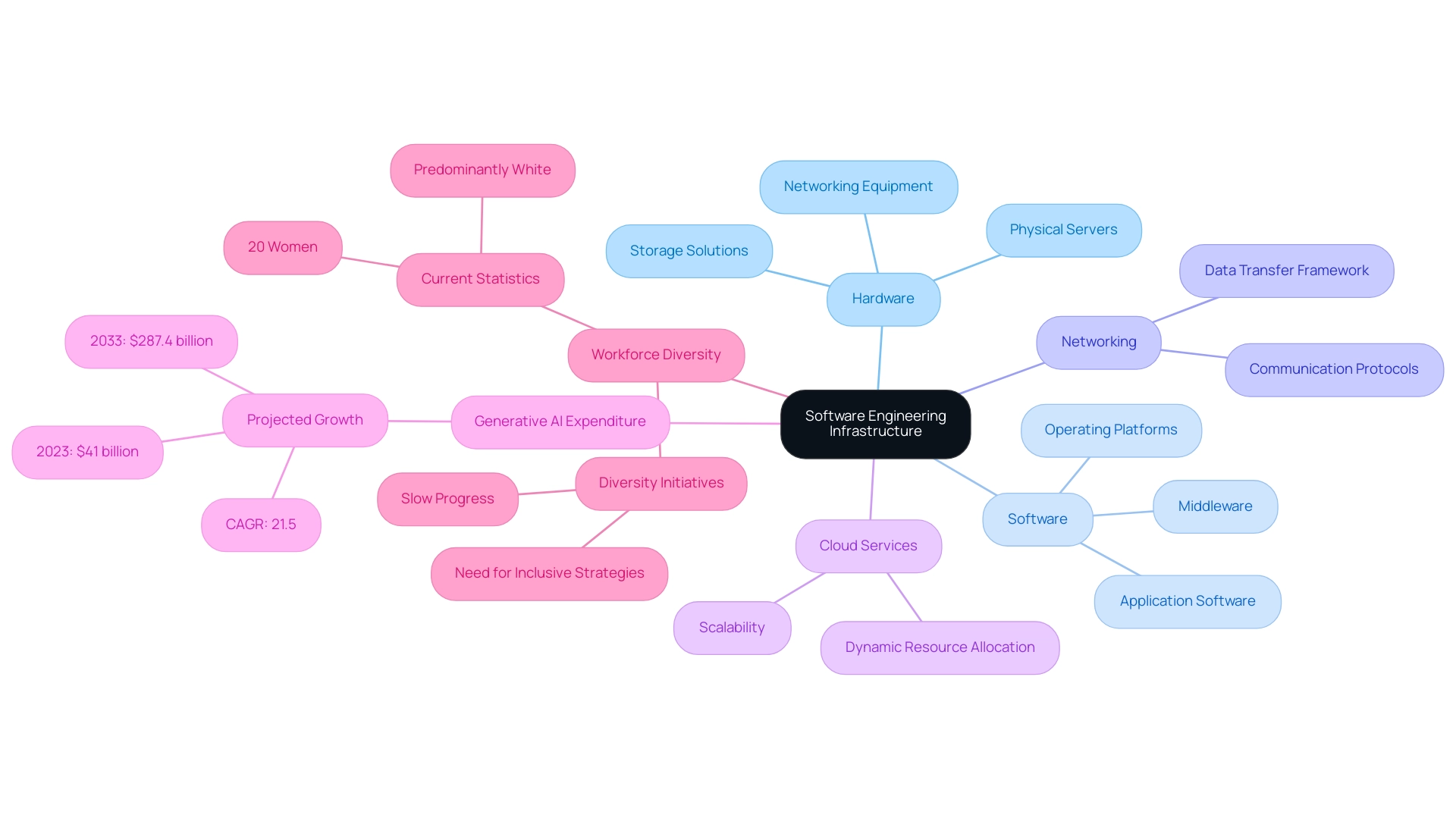
The Role of Infrastructure Engineers: Responsibilities and Impact
Systems specialists are vital to the application development lifecycle, holding a key duty for creating, executing, and upkeeping the framework that supports application functionalities. Their key responsibilities encompass the following areas:
-
Infrastructure Development: Infrastructure engineers assess business requirements to build architectures that guarantee scalability, reliability, and security, thus aligning technical solutions with organizational needs.
-
Deployment: They are responsible for overseeing the deployment of software applications, guaranteeing that the requisite infrastructure is established and operates effectively to support these applications.
-
Monitoring and Maintenance: Continuous system monitoring is vital for preemptively identifying and mitigating issues that could disrupt user experiences.
Infrastructure specialists focus on the infrastructure in software engineering to establish and execute maintenance protocols that ensure optimal performance and availability.
-
Cooperation: Effective collaboration with application developers, operations teams, and various stakeholders is essential to ensure that the framework aligns with application requirements and overall business objectives.
-
Innovation and Optimization: Professionals in systems design actively pursue chances for improvement and innovation by utilizing emerging technologies, which not only enhances performance but also optimizes expenses.
The impact of these specialists goes beyond conventional maintenance roles; they are crucial to the success of development projects. Their knowledge in system design and management drives efficiencies and equips organizations to navigate the evolving technological landscape. By ensuring that software systems are robust and secure, system architects significantly contribute to meeting the demands of both users and businesses, ultimately shaping project outcomes.
In California, the salary range for system architects is quite broad, from $85,491 to $230,479, reflecting the critical nature of their role in the industry. Moreover, job vacancies for construction specialists in the state emphasize a robust need for these professionals, with salaries between $104,000 and $220,000 presented by different firms. As highlighted by US News and World Report, engineering career trajectories, including those of structural specialists, exhibit faster than average job growth rates and offer lucrative salaries, emphasizing the significance of these positions in today’s employment landscape.
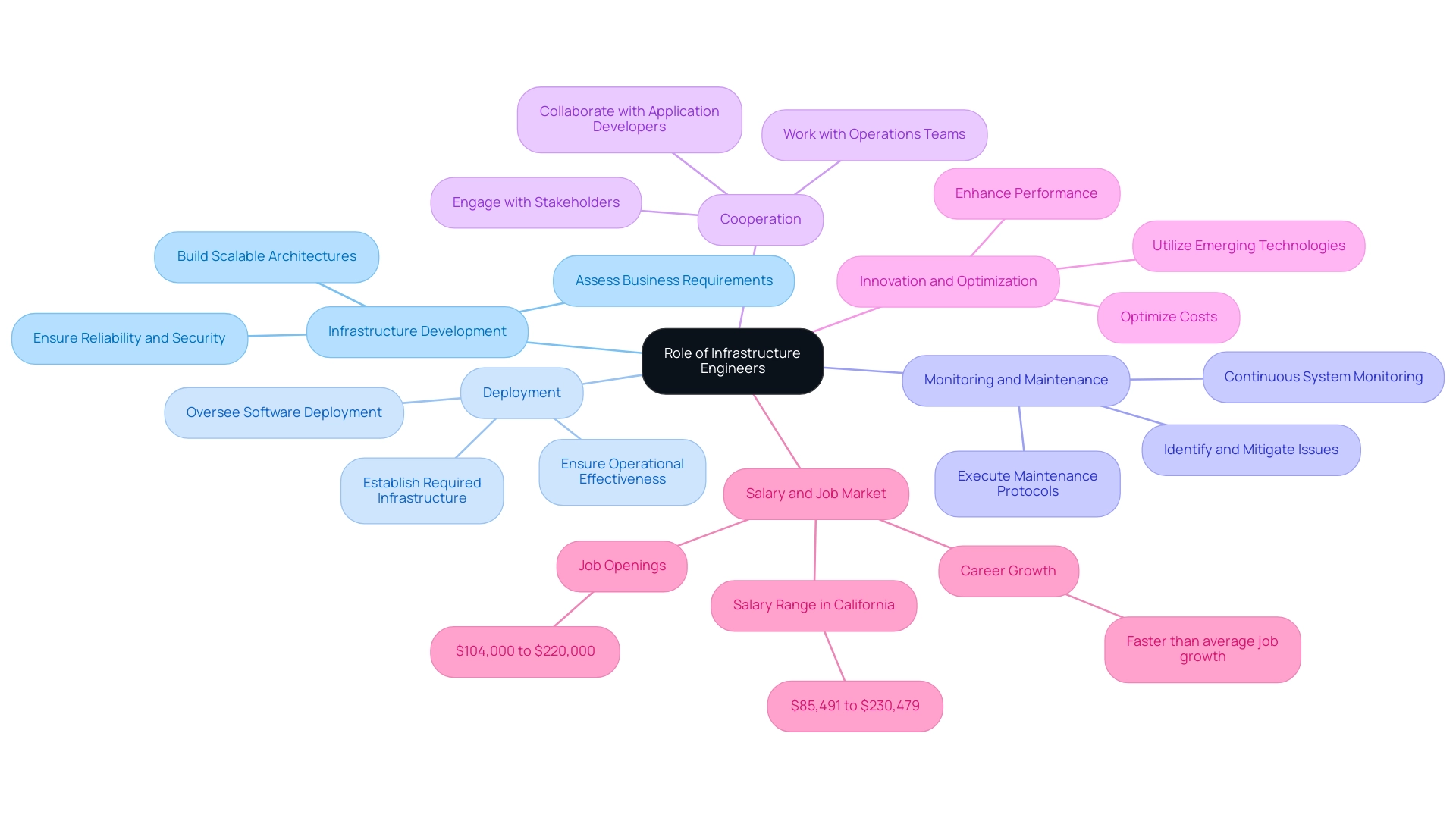
Common Infrastructure Challenges in Software Engineering
Infrastructure specialists face various obstacles that can greatly influence the efficiency and effectiveness of applications built on infrastructure in software engineering. Among the most pressing issues are:
- Scalability: As organizations expand, their infrastructure must accommodate increased loads and data traffic.
The ability to scale infrastructure in software engineering without sacrificing performance poses a considerable challenge for engineers. Notably, CI/CD practices are essential for modern DevOps, enhancing collaboration and software delivery quality, with the continuous integration tools market valued at $1.4 billion and expected to grow to $3.72 billion by 2029.
- Security: Safeguarding infrastructure against cyber threats is a critical priority.
Engineers are tasked with implementing robust security measures that protect sensitive information while ensuring compliance with regulatory demands. As one expert succinctly puts it,
Enforce core requirements to protect the organization and its customers, and meet compliance demands.
- Integration: The emergence of various tools and platforms brings challenges in unifying distinct setups.
Infrastructure specialists must ensure seamless interoperability among all components within the infrastructure in software engineering to maintain operational efficiency. I&O leaders should partner closely with platform users to build and evolve DevOps toolchains in hybrid cloud environments to address this integration challenge effectively.
- Cost Management: Achieving a balance between performance and cost often requires meticulous planning.
Engineers must make informed decisions regarding resource allocation and technology investments to optimize budgetary constraints.
- Legacy Systems: Many organizations continue to depend on outdated technologies, presenting unique challenges.
Infrastructure engineers must adeptly navigate the integration of new solutions with legacy frameworks, considering the infrastructure in software engineering that may not align with contemporary requirements.
This is especially pertinent as the continuous development of CI/CD practices underscores the necessity for compatibility with legacy systems to guarantee efficient application delivery.
Successfully tackling these challenges requires a combination of technical knowledge, strategic vision, and teamwork across groups to ensure that systems align with overall business goals. Furthermore, the statistic that 68% of IT teams have an upskilling program in place underscores the industry's proactive response to these challenges.
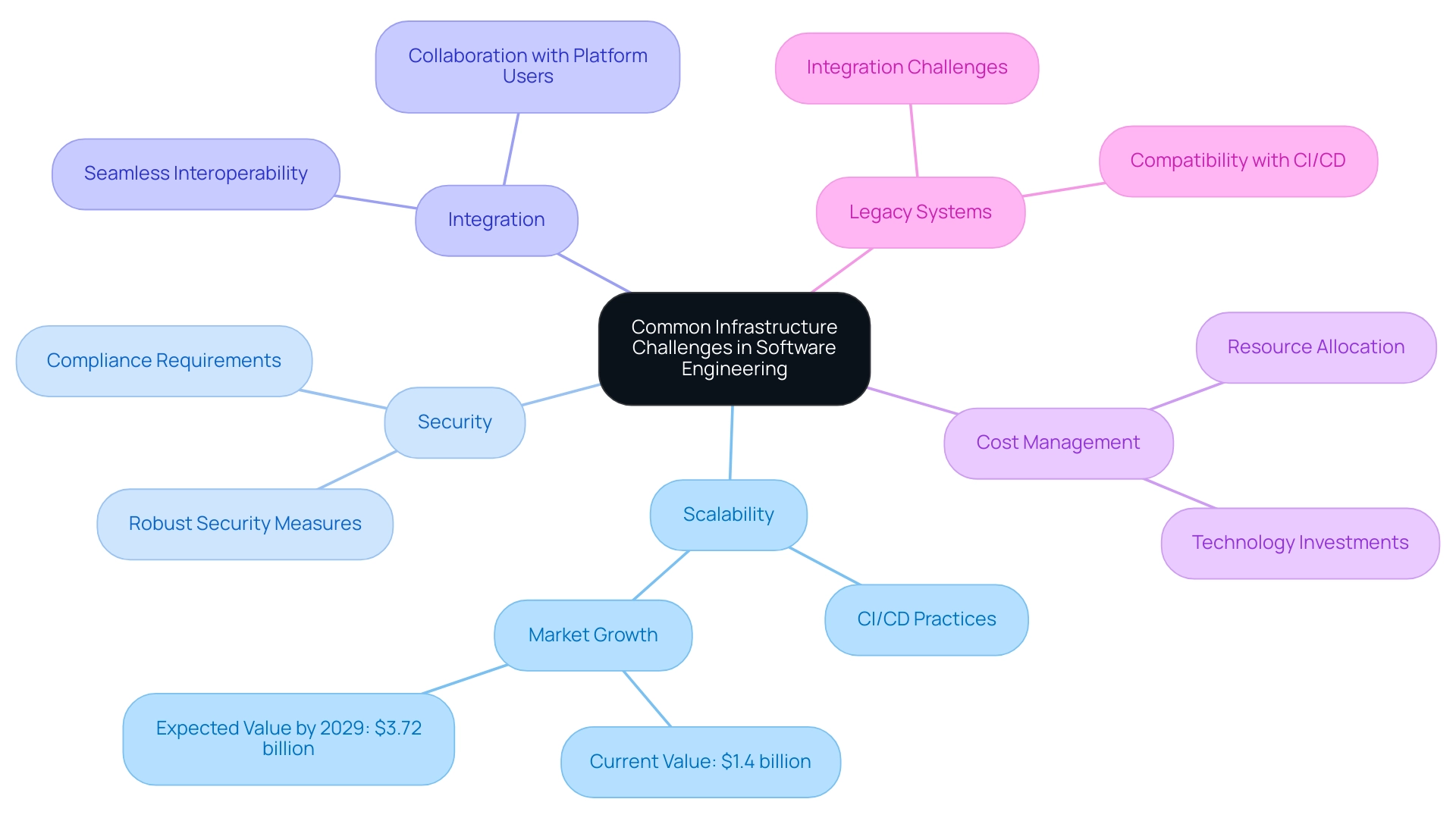
Emerging Trends in Software Engineering Infrastructure
As technology continues to evolve, several pivotal trends are reshaping the landscape of software engineering infrastructure:
-
Cloud Computing: The transition to cloud-based solutions is not merely a trend but a strategic imperative. Organizations are increasingly embracing hybrid and multi-cloud strategies, which facilitate greater scalability, flexibility, and cost-effectiveness. Notably, half of the surveyed businesses have moved to the cloud for disaster recovery, underscoring its critical role in data protection strategies. As Veeam states, "The cloud plays a crucial role in today’s data protection strategy, according to half of the surveyed businesses."
-
DevOps Practices: The convergence of development and operations through DevOps practices fosters enhanced collaboration and efficiency. A key aspect of this integration is Infrastructure as Code (IAC), which has emerged as a standard practice. IAC allows for automated provisioning and management of resources, streamlining processes and minimizing the potential for human error.
-
Microservices Architecture: This architectural approach empowers organizations to develop applications as a suite of small, independent services. It not only improves scalability and maintainability but also requires a paradigm shift in management to effectively support these distributed architectures.
-
AI and Automation: The integration of artificial intelligence and machine learning into system management is revolutionizing operations. These technologies facilitate predictive analytics, automated monitoring, and rapid incident response, significantly bolstering operational efficiency and resilience.
-
Edge Computing: With the proliferation of IoT devices, the need to process data closer to its source has never been more critical. Edge computing reduces latency and enhances bandwidth utilization, urging systems developers to adjust to novel deployment models that fulfill these requirements.
-
Simplification of Cloud Computing: The trend towards simplifying cloud computing for non-technical users includes the rise of no-code and low-code tools, which enable individuals to develop applications without needing extensive technical skills. This democratization of cloud tools enhances accessibility and usability, allowing a broader range of users to leverage cloud services effectively.
Staying aware of these trends is crucial for engineers as they navigate the complexities of infrastructure in software engineering. By doing so, they can ensure their organizations maintain a competitive edge in a rapidly evolving technological landscape, particularly as 2024 is projected to be a dynamic year characterized by agility, innovation, and adaptability.
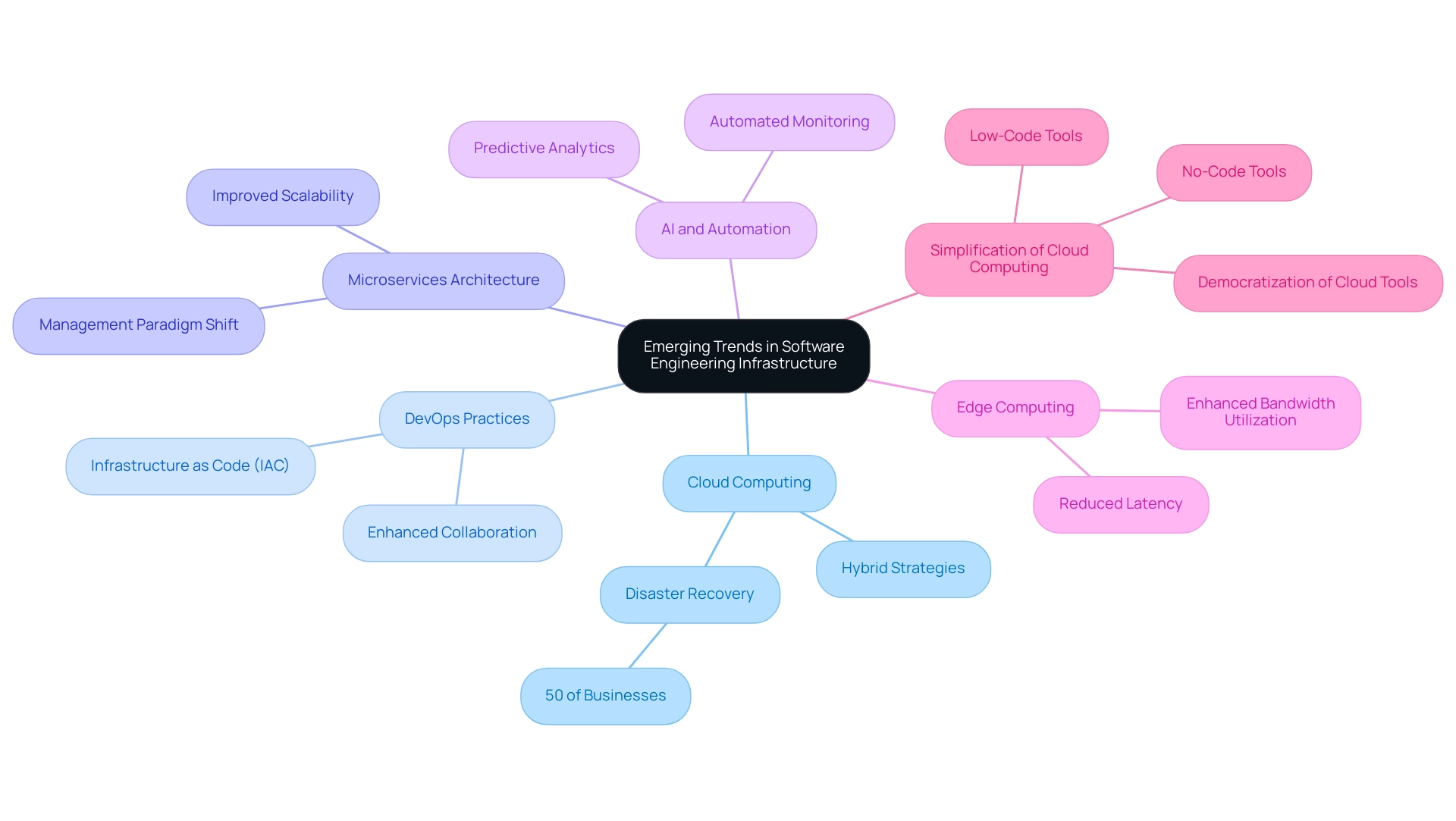
Best Practices for Managing Software Engineering Infrastructure
To effectively manage software engineering systems, organizations should adopt the following best practices:
- Regular Audits: Implementing routine assessments of system components is essential for identifying vulnerabilities, inefficiencies, and opportunities for improvement. This proactive approach can lead to a 20% improvement in operational efficiency, underscoring its importance in the infrastructure in software engineering.
-
Documentation: Comprehensive documentation of system setups, processes, and configurations is crucial. It not only ensures consistency but also facilitates troubleshooting and streamlines the onboarding of new team members. As Yuliia Zhuravlova aptly states,
> Don’t reinvent the wheel
this principle applies to leveraging existing knowledge through effective documentation. -
Automation: The integration of automation in routine tasks such as monitoring, backups, and deployments minimizes human error and enhances efficiency. By automating these processes, teams can allocate more resources to strategic initiatives, thereby increasing overall productivity. Such practices are particularly important in light of the 68% of developers who report facing unexpected challenges in nearly half of their projects; automation can help reduce these challenges by streamlining operations.
-
Collaboration: Cultivating a collaborative environment among development, operations, and support teams fosters improved communication and alignment. This synergy results in more effective system solutions and a more agile response to challenges.
-
Continuous Learning: Infrastructure engineers must stay informed about industry trends, emerging technologies, and best practices through ongoing education and training. This commitment to continuous learning is vital for maintaining effectiveness in their roles, particularly in relation to the infrastructure in software engineering, especially considering the challenges faced by many developers.
Additionally, organizations should consider the insights from the case study on the cost of implementing DevOps, which highlights that understanding the current state of an organization and the scope of goals is crucial for estimating the investment required for a successful transformation. By applying these best practices, organizations not only enhance their management of infrastructure in software engineering but also improve their overall success and agility in an increasingly competitive landscape. In sectors like retail and e-commerce—where 38.5% of software development projects occur—these practices can lead to significant operational improvements and strategic advantages.
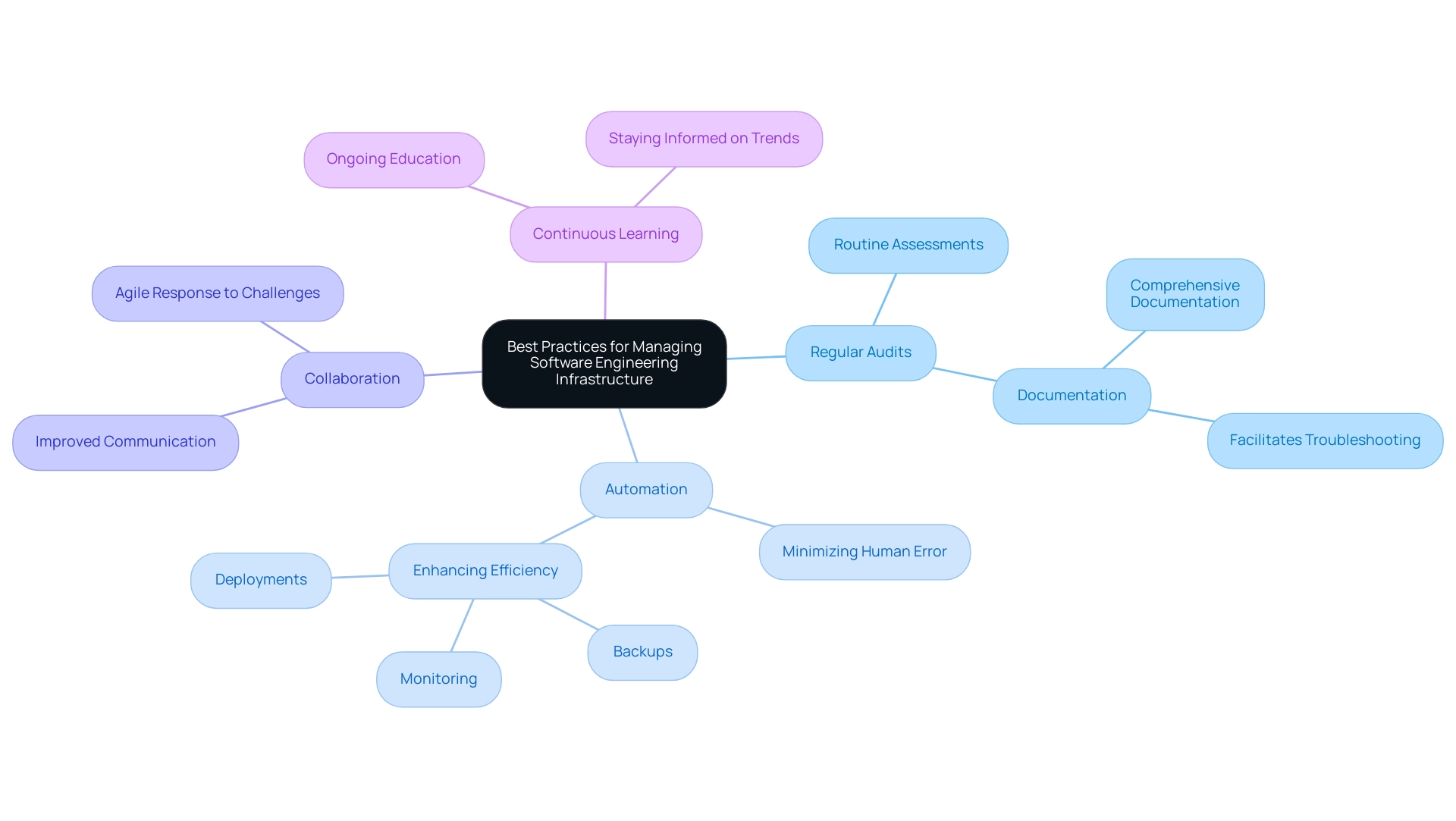
Conclusion
The exploration of software engineering infrastructure reveals its fundamental role in the successful development and deployment of applications. Key components such as hardware, software, networking, and cloud services form the backbone of this infrastructure, providing the necessary support for robust and efficient software systems. Infrastructure engineers play a critical role in this ecosystem, ensuring that systems are designed, deployed, and maintained to meet the ever-evolving demands of organizations. Their responsibilities extend beyond technical tasks; they are instrumental in fostering collaboration and driving innovation within software projects.
However, the path to effective infrastructure management is fraught with challenges, including:
- Scalability
- Security
- Integration
- Cost management
- The complexities introduced by legacy systems
Addressing these issues requires a blend of technical expertise and strategic foresight, as well as a commitment to ongoing professional development. Emerging trends such as cloud computing, DevOps practices, microservices architecture, and the integration of AI and automation are reshaping the landscape, presenting both opportunities and challenges for infrastructure engineers.
To navigate this dynamic environment successfully, organizations must adopt best practices that emphasize:
- Regular audits
- Comprehensive documentation
- Automation
- Collaboration
- Continuous learning
By implementing these strategies, organizations can enhance their infrastructure management capabilities, ensuring they remain agile and competitive in a fast-paced technological landscape. Ultimately, a well-structured software engineering infrastructure not only supports the successful delivery of applications but also drives the overall success of an organization in today’s digital age.




